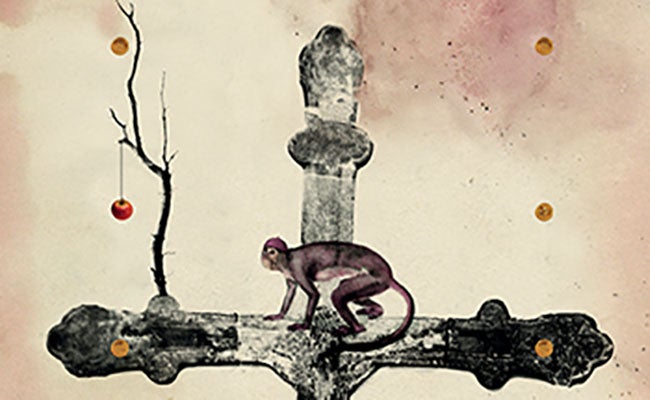Illustrating Folly
Artist Matthew Richardson on how he created a visual rhetoric to match Erasmus's In Praise of Folly.
[caption id="attachment_2508" align="alignright" width="350"] Folly of Clergy[/caption]
The most striking feature of Eramus' writing is his use of rhetoric in recasting and recomposing older texts, using puns, metaphor, hyperbole and a host of other literary devices. When I began to think about ideas for illustrations to accompany In Praise of Folly, it occurred to me that Erasmus, the great intellectual innovator of his day, might well approve a new visual interpretation, a reformulation of the illustrations Hans Holbein the Younger had made for one of the early editions of the book.
My first idea was to make Holbein’s work the basis for a series of collages, adding something of my own to the mix. In the end, I used only partial elements. I did, however, retain the idea of ‘stages’ or backgrounds from Holbein’s drawings. I removed the ‘action’ that Holbein had shown and created my own – new actors performing on a much older stage. I attempted a visual rhetoric to match Erasmus’ verbal inventiveness, and, in developing ideas, thought about how visual meaning – symbols and signs – drift and transform over time, and certainly over a span of five hundred years.
Double or triple meanings occur throughout In Praise of Folly, and the way I tackled visual ideas tries to echo this aspect of multiple layers – where an image or object may signify more than one thing. In my illustrations, the intention can be hidden, lost – or obvious. Sometimes ideas are veiled, sometimes they are direct. Erasmus was a close friend of Sir Thomas More, his intellectual sparring partner and someone who shared his dry humour. Moriae Encomium (the book’s Latin title) can also be read as In Praise of More. The enigmatic text on the back cover alludes to this private joke, the misaligned letter forms recalling the recent invention of movable type in printmaking. The composition of elements on the cover is fragile and might collapse or fall away – a visualisation of acts of ‘folly’. The white ladder represents a journey between earth and heaven, and along with the black ladder, forms a cross, almost suggestive of a Bible. However, the shape of the cross is being subtly pushed out of position by a bubble (of hot air, wind, overblown speech?) – a critique of the Church. The white ladder can be used to reach and change a lightbulb – a playful symbol of the ‘Enlightenment’. Foolishly though, the person attempting this job has probably had one drink too many – there is at least evidence – an empty goblet rests at the base of the ladder.
[caption id="attachment_2507" align="alignleft" width="730"]
Folly of Clergy[/caption]
The most striking feature of Eramus' writing is his use of rhetoric in recasting and recomposing older texts, using puns, metaphor, hyperbole and a host of other literary devices. When I began to think about ideas for illustrations to accompany In Praise of Folly, it occurred to me that Erasmus, the great intellectual innovator of his day, might well approve a new visual interpretation, a reformulation of the illustrations Hans Holbein the Younger had made for one of the early editions of the book.
My first idea was to make Holbein’s work the basis for a series of collages, adding something of my own to the mix. In the end, I used only partial elements. I did, however, retain the idea of ‘stages’ or backgrounds from Holbein’s drawings. I removed the ‘action’ that Holbein had shown and created my own – new actors performing on a much older stage. I attempted a visual rhetoric to match Erasmus’ verbal inventiveness, and, in developing ideas, thought about how visual meaning – symbols and signs – drift and transform over time, and certainly over a span of five hundred years.
Double or triple meanings occur throughout In Praise of Folly, and the way I tackled visual ideas tries to echo this aspect of multiple layers – where an image or object may signify more than one thing. In my illustrations, the intention can be hidden, lost – or obvious. Sometimes ideas are veiled, sometimes they are direct. Erasmus was a close friend of Sir Thomas More, his intellectual sparring partner and someone who shared his dry humour. Moriae Encomium (the book’s Latin title) can also be read as In Praise of More. The enigmatic text on the back cover alludes to this private joke, the misaligned letter forms recalling the recent invention of movable type in printmaking. The composition of elements on the cover is fragile and might collapse or fall away – a visualisation of acts of ‘folly’. The white ladder represents a journey between earth and heaven, and along with the black ladder, forms a cross, almost suggestive of a Bible. However, the shape of the cross is being subtly pushed out of position by a bubble (of hot air, wind, overblown speech?) – a critique of the Church. The white ladder can be used to reach and change a lightbulb – a playful symbol of the ‘Enlightenment’. Foolishly though, the person attempting this job has probably had one drink too many – there is at least evidence – an empty goblet rests at the base of the ladder.
[caption id="attachment_2507" align="alignleft" width="730"] From left: Folly of Kings and Folly of Intellectuals[/caption]
In Praise of Folly is a mix of observation, wit and satire narrated through the voice of Folly – a goddess, dressed as a jester, celebrating frivolity, self-deception, inebriation, ignorance, self-love, flattery and pleasure. Erasmus uses the character of Folly as a mask behind which he can attack the orthodoxies of his day and lambast the teachers, professors, theologians and prelates still toiling in the web of medieval scholasticism.
When I was thinking about the representation of Folly, I looked at different characterisations and enactments of who Folly was and where she might be found. I looked across time and in different cultures, and especially at the discovery of truth through misrule, mockery, ribaldry and excess. I looked at the Fool, the Jester, commedia dell’arte, Pierrot, the Folies-Bergère, the Mardi Gras carnival, and also more recent characters like Carmen Miranda, the Cat in the Hat and ‘jester punk’ Malcolm McLaren. So within the illustrations there may be ghosts or layered references to these aspects – to different historical frames speaking as Folly. For example, the portrait of Folly shows her holding a feather duster – both a cleaning tool to brush away the cobwebs of mystification and also, like Ken Dodd’s ‘tickling stick’, a tool of distraction to make us laugh. In addition, it represents and enlarges the female aspect of this personification by Erasmus. Her ruff is at the same time a marker of medieval elegance and the emblem of ‘the clown’.
[caption id="attachment_2518" align="alignleft" width="700"]
From left: Folly of Kings and Folly of Intellectuals[/caption]
In Praise of Folly is a mix of observation, wit and satire narrated through the voice of Folly – a goddess, dressed as a jester, celebrating frivolity, self-deception, inebriation, ignorance, self-love, flattery and pleasure. Erasmus uses the character of Folly as a mask behind which he can attack the orthodoxies of his day and lambast the teachers, professors, theologians and prelates still toiling in the web of medieval scholasticism.
When I was thinking about the representation of Folly, I looked at different characterisations and enactments of who Folly was and where she might be found. I looked across time and in different cultures, and especially at the discovery of truth through misrule, mockery, ribaldry and excess. I looked at the Fool, the Jester, commedia dell’arte, Pierrot, the Folies-Bergère, the Mardi Gras carnival, and also more recent characters like Carmen Miranda, the Cat in the Hat and ‘jester punk’ Malcolm McLaren. So within the illustrations there may be ghosts or layered references to these aspects – to different historical frames speaking as Folly. For example, the portrait of Folly shows her holding a feather duster – both a cleaning tool to brush away the cobwebs of mystification and also, like Ken Dodd’s ‘tickling stick’, a tool of distraction to make us laugh. In addition, it represents and enlarges the female aspect of this personification by Erasmus. Her ruff is at the same time a marker of medieval elegance and the emblem of ‘the clown’.
[caption id="attachment_2518" align="alignleft" width="700"] Running sheets of some of Matthew's illustrations for the Folio edition of In Praise of Folly[/caption]
I was interested to learn that in 1511, when Erasmus published In Praise of Folly, his writings accounted for almost a quarter of all books printed and produced. I wanted to include an early printing press, as it was so pivotal to publicising his ideas and the means by which In Praise of Folly achieved its great success. In Folly of Teachers I show the printing press that, along with a boom in maritime trade, created a new circulation of knowledge, a rapid flow of information and a washing through of the established social order.
Folly of Intellectuals shows an academic obsessed with measuring, working things out ‘in theory’ and looking only to books for answers. As he gazes upwards, unnoticed by him, reality bites – a tower, perhaps his home (or Rome?) burns. In Folly of Kings the monarch is literally borne down by the weight of his crowns and insignia. Erasmus treats kings as more interested in flattery, entertainment and self-indulgence than affairs of state. The gold and silver poodle suggests vanity, primping and pomp. It is also a toy – a plaything for the king’s foolish amusement. In Folly of Clergy an apple tempts a monkey. The image looks superficially like a High Church altar, but the arrangement of objects suggests a more earthly – or earthy – taste for food, drink (Abbot Ale, Bishops Finger), money and enjoyment. Finally we see ‘Folly’ revealed as Erasmus himself. He has cast off his comic mask and now contemplates a world unadorned by literary artifice, a world of humanist clarity, in which he speaks plainly, saying what he means and meaning what he says.
See more of Richardson’s illustrations and explore our edition of In Praise of Folly here.
[caption id="attachment_2535" align="aligncenter" width="290"]
Running sheets of some of Matthew's illustrations for the Folio edition of In Praise of Folly[/caption]
I was interested to learn that in 1511, when Erasmus published In Praise of Folly, his writings accounted for almost a quarter of all books printed and produced. I wanted to include an early printing press, as it was so pivotal to publicising his ideas and the means by which In Praise of Folly achieved its great success. In Folly of Teachers I show the printing press that, along with a boom in maritime trade, created a new circulation of knowledge, a rapid flow of information and a washing through of the established social order.
Folly of Intellectuals shows an academic obsessed with measuring, working things out ‘in theory’ and looking only to books for answers. As he gazes upwards, unnoticed by him, reality bites – a tower, perhaps his home (or Rome?) burns. In Folly of Kings the monarch is literally borne down by the weight of his crowns and insignia. Erasmus treats kings as more interested in flattery, entertainment and self-indulgence than affairs of state. The gold and silver poodle suggests vanity, primping and pomp. It is also a toy – a plaything for the king’s foolish amusement. In Folly of Clergy an apple tempts a monkey. The image looks superficially like a High Church altar, but the arrangement of objects suggests a more earthly – or earthy – taste for food, drink (Abbot Ale, Bishops Finger), money and enjoyment. Finally we see ‘Folly’ revealed as Erasmus himself. He has cast off his comic mask and now contemplates a world unadorned by literary artifice, a world of humanist clarity, in which he speaks plainly, saying what he means and meaning what he says.
See more of Richardson’s illustrations and explore our edition of In Praise of Folly here.
[caption id="attachment_2535" align="aligncenter" width="290"] The 2014 Folio edition of In Praise of Folly[/caption]
The 2014 Folio edition of In Praise of Folly[/caption]
 Folly of Clergy[/caption]
The most striking feature of Eramus' writing is his use of rhetoric in recasting and recomposing older texts, using puns, metaphor, hyperbole and a host of other literary devices. When I began to think about ideas for illustrations to accompany In Praise of Folly, it occurred to me that Erasmus, the great intellectual innovator of his day, might well approve a new visual interpretation, a reformulation of the illustrations Hans Holbein the Younger had made for one of the early editions of the book.
My first idea was to make Holbein’s work the basis for a series of collages, adding something of my own to the mix. In the end, I used only partial elements. I did, however, retain the idea of ‘stages’ or backgrounds from Holbein’s drawings. I removed the ‘action’ that Holbein had shown and created my own – new actors performing on a much older stage. I attempted a visual rhetoric to match Erasmus’ verbal inventiveness, and, in developing ideas, thought about how visual meaning – symbols and signs – drift and transform over time, and certainly over a span of five hundred years.
Double or triple meanings occur throughout In Praise of Folly, and the way I tackled visual ideas tries to echo this aspect of multiple layers – where an image or object may signify more than one thing. In my illustrations, the intention can be hidden, lost – or obvious. Sometimes ideas are veiled, sometimes they are direct. Erasmus was a close friend of Sir Thomas More, his intellectual sparring partner and someone who shared his dry humour. Moriae Encomium (the book’s Latin title) can also be read as In Praise of More. The enigmatic text on the back cover alludes to this private joke, the misaligned letter forms recalling the recent invention of movable type in printmaking. The composition of elements on the cover is fragile and might collapse or fall away – a visualisation of acts of ‘folly’. The white ladder represents a journey between earth and heaven, and along with the black ladder, forms a cross, almost suggestive of a Bible. However, the shape of the cross is being subtly pushed out of position by a bubble (of hot air, wind, overblown speech?) – a critique of the Church. The white ladder can be used to reach and change a lightbulb – a playful symbol of the ‘Enlightenment’. Foolishly though, the person attempting this job has probably had one drink too many – there is at least evidence – an empty goblet rests at the base of the ladder.
[caption id="attachment_2507" align="alignleft" width="730"]
Folly of Clergy[/caption]
The most striking feature of Eramus' writing is his use of rhetoric in recasting and recomposing older texts, using puns, metaphor, hyperbole and a host of other literary devices. When I began to think about ideas for illustrations to accompany In Praise of Folly, it occurred to me that Erasmus, the great intellectual innovator of his day, might well approve a new visual interpretation, a reformulation of the illustrations Hans Holbein the Younger had made for one of the early editions of the book.
My first idea was to make Holbein’s work the basis for a series of collages, adding something of my own to the mix. In the end, I used only partial elements. I did, however, retain the idea of ‘stages’ or backgrounds from Holbein’s drawings. I removed the ‘action’ that Holbein had shown and created my own – new actors performing on a much older stage. I attempted a visual rhetoric to match Erasmus’ verbal inventiveness, and, in developing ideas, thought about how visual meaning – symbols and signs – drift and transform over time, and certainly over a span of five hundred years.
Double or triple meanings occur throughout In Praise of Folly, and the way I tackled visual ideas tries to echo this aspect of multiple layers – where an image or object may signify more than one thing. In my illustrations, the intention can be hidden, lost – or obvious. Sometimes ideas are veiled, sometimes they are direct. Erasmus was a close friend of Sir Thomas More, his intellectual sparring partner and someone who shared his dry humour. Moriae Encomium (the book’s Latin title) can also be read as In Praise of More. The enigmatic text on the back cover alludes to this private joke, the misaligned letter forms recalling the recent invention of movable type in printmaking. The composition of elements on the cover is fragile and might collapse or fall away – a visualisation of acts of ‘folly’. The white ladder represents a journey between earth and heaven, and along with the black ladder, forms a cross, almost suggestive of a Bible. However, the shape of the cross is being subtly pushed out of position by a bubble (of hot air, wind, overblown speech?) – a critique of the Church. The white ladder can be used to reach and change a lightbulb – a playful symbol of the ‘Enlightenment’. Foolishly though, the person attempting this job has probably had one drink too many – there is at least evidence – an empty goblet rests at the base of the ladder.
[caption id="attachment_2507" align="alignleft" width="730"] From left: Folly of Kings and Folly of Intellectuals[/caption]
In Praise of Folly is a mix of observation, wit and satire narrated through the voice of Folly – a goddess, dressed as a jester, celebrating frivolity, self-deception, inebriation, ignorance, self-love, flattery and pleasure. Erasmus uses the character of Folly as a mask behind which he can attack the orthodoxies of his day and lambast the teachers, professors, theologians and prelates still toiling in the web of medieval scholasticism.
When I was thinking about the representation of Folly, I looked at different characterisations and enactments of who Folly was and where she might be found. I looked across time and in different cultures, and especially at the discovery of truth through misrule, mockery, ribaldry and excess. I looked at the Fool, the Jester, commedia dell’arte, Pierrot, the Folies-Bergère, the Mardi Gras carnival, and also more recent characters like Carmen Miranda, the Cat in the Hat and ‘jester punk’ Malcolm McLaren. So within the illustrations there may be ghosts or layered references to these aspects – to different historical frames speaking as Folly. For example, the portrait of Folly shows her holding a feather duster – both a cleaning tool to brush away the cobwebs of mystification and also, like Ken Dodd’s ‘tickling stick’, a tool of distraction to make us laugh. In addition, it represents and enlarges the female aspect of this personification by Erasmus. Her ruff is at the same time a marker of medieval elegance and the emblem of ‘the clown’.
[caption id="attachment_2518" align="alignleft" width="700"]
From left: Folly of Kings and Folly of Intellectuals[/caption]
In Praise of Folly is a mix of observation, wit and satire narrated through the voice of Folly – a goddess, dressed as a jester, celebrating frivolity, self-deception, inebriation, ignorance, self-love, flattery and pleasure. Erasmus uses the character of Folly as a mask behind which he can attack the orthodoxies of his day and lambast the teachers, professors, theologians and prelates still toiling in the web of medieval scholasticism.
When I was thinking about the representation of Folly, I looked at different characterisations and enactments of who Folly was and where she might be found. I looked across time and in different cultures, and especially at the discovery of truth through misrule, mockery, ribaldry and excess. I looked at the Fool, the Jester, commedia dell’arte, Pierrot, the Folies-Bergère, the Mardi Gras carnival, and also more recent characters like Carmen Miranda, the Cat in the Hat and ‘jester punk’ Malcolm McLaren. So within the illustrations there may be ghosts or layered references to these aspects – to different historical frames speaking as Folly. For example, the portrait of Folly shows her holding a feather duster – both a cleaning tool to brush away the cobwebs of mystification and also, like Ken Dodd’s ‘tickling stick’, a tool of distraction to make us laugh. In addition, it represents and enlarges the female aspect of this personification by Erasmus. Her ruff is at the same time a marker of medieval elegance and the emblem of ‘the clown’.
[caption id="attachment_2518" align="alignleft" width="700"] Running sheets of some of Matthew's illustrations for the Folio edition of In Praise of Folly[/caption]
I was interested to learn that in 1511, when Erasmus published In Praise of Folly, his writings accounted for almost a quarter of all books printed and produced. I wanted to include an early printing press, as it was so pivotal to publicising his ideas and the means by which In Praise of Folly achieved its great success. In Folly of Teachers I show the printing press that, along with a boom in maritime trade, created a new circulation of knowledge, a rapid flow of information and a washing through of the established social order.
Folly of Intellectuals shows an academic obsessed with measuring, working things out ‘in theory’ and looking only to books for answers. As he gazes upwards, unnoticed by him, reality bites – a tower, perhaps his home (or Rome?) burns. In Folly of Kings the monarch is literally borne down by the weight of his crowns and insignia. Erasmus treats kings as more interested in flattery, entertainment and self-indulgence than affairs of state. The gold and silver poodle suggests vanity, primping and pomp. It is also a toy – a plaything for the king’s foolish amusement. In Folly of Clergy an apple tempts a monkey. The image looks superficially like a High Church altar, but the arrangement of objects suggests a more earthly – or earthy – taste for food, drink (Abbot Ale, Bishops Finger), money and enjoyment. Finally we see ‘Folly’ revealed as Erasmus himself. He has cast off his comic mask and now contemplates a world unadorned by literary artifice, a world of humanist clarity, in which he speaks plainly, saying what he means and meaning what he says.
See more of Richardson’s illustrations and explore our edition of In Praise of Folly here.
[caption id="attachment_2535" align="aligncenter" width="290"]
Running sheets of some of Matthew's illustrations for the Folio edition of In Praise of Folly[/caption]
I was interested to learn that in 1511, when Erasmus published In Praise of Folly, his writings accounted for almost a quarter of all books printed and produced. I wanted to include an early printing press, as it was so pivotal to publicising his ideas and the means by which In Praise of Folly achieved its great success. In Folly of Teachers I show the printing press that, along with a boom in maritime trade, created a new circulation of knowledge, a rapid flow of information and a washing through of the established social order.
Folly of Intellectuals shows an academic obsessed with measuring, working things out ‘in theory’ and looking only to books for answers. As he gazes upwards, unnoticed by him, reality bites – a tower, perhaps his home (or Rome?) burns. In Folly of Kings the monarch is literally borne down by the weight of his crowns and insignia. Erasmus treats kings as more interested in flattery, entertainment and self-indulgence than affairs of state. The gold and silver poodle suggests vanity, primping and pomp. It is also a toy – a plaything for the king’s foolish amusement. In Folly of Clergy an apple tempts a monkey. The image looks superficially like a High Church altar, but the arrangement of objects suggests a more earthly – or earthy – taste for food, drink (Abbot Ale, Bishops Finger), money and enjoyment. Finally we see ‘Folly’ revealed as Erasmus himself. He has cast off his comic mask and now contemplates a world unadorned by literary artifice, a world of humanist clarity, in which he speaks plainly, saying what he means and meaning what he says.
See more of Richardson’s illustrations and explore our edition of In Praise of Folly here.
[caption id="attachment_2535" align="aligncenter" width="290"] The 2014 Folio edition of In Praise of Folly[/caption]
The 2014 Folio edition of In Praise of Folly[/caption]

